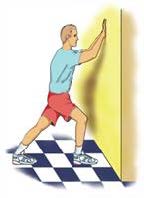Posterior Ankle Endoscopy/Arthroscopy
Posterior ankle endoscopy/arthroscopy is a technique used to look at and treat problems in the back of the ankle.
First, it’s important to understand ankle anatomy. The ankle joint is the joint between the lower leg bones (tibia and fibula) and the ankle bone (talus). The joint below the ankle joint is called the subtalar joint; it lies between the ankle bone and the heel bone (calcaneus). The talus has a bony prominence in the back next to the flexor hallucis longus (FHL) tendon. This is the tendon that moves the big toe downward toward the floor.
The bony posterior prominence might be the cause of ankle pain in some people if it is large (called a trigonal process) or it is not completely fused with the talar bone (called an os trigonum).
Pain might also occur if the FHL tendon gets irritated. This can happen if the tendon doesn’t fit well because the tunnel is too tight or the tendon is too big, or if the tendon is inflamed and swollen (called tenosynovitis).
An ankle sprain may cause a tear of the posterior ankle ligaments. The torn pieces can flip inside the joint. They can get pinched between the joint surfaces and cause pain. This problem is called posterior soft tissue impingement.
The Achilles tendon attaches to the back of the heel bone. It can get pinched by a prominent piece of bone at the top of the heel (called a Haglund’s deformity). This can lead to wear of the Achilles tendon and calcium deposits in the tendon (called insertional Achilles tendinitis).
Diagnosis
Patients typically experience pain in the back of the ankle. The precise location of the pain may differ depending on the cause. The pain from Achilles tendinitis is typically at the surface in back of the heel. This pain often increases when wearing closed shoes and improves with shoes that have open heels (e.g. clogs).
The pain from an os trigonum, an FHL problem or posterior soft tissue impingement tends to be deeper. It typically increases with downward motion of the ankle (pointing the toes). Soccer players and ballet dancers tend to be at higher risk for these problems.
You should avoid a posterior ankle endoscopy or arthroscopy if you have Infection in the skin or soft tissue of the posterior ankle area. You should discuss all of your medical conditions with your surgeon before you have this procedure.
Surgery should be considered after at least three months or non-surgical treatment has failed. Non-surgical approaches include rest, anti-inflammatory medications, a cast or walking boot for a short period of time, physical therapy and local steroid injection.
An X-ray can diagnose an os trigonum or enlarged trigonal process and can reveal other bony problems. MRI can be beneficial in evaluating soft tissues such as ligaments and tendons. In some cases, MRI can provide a better understanding of the problem.
Treatment
With the patient lying face-down or on the side, the foot and ankle orthopedic surgeon makes incisions at the back of the ankle. Typically, two incisions are made on either side of the Achilles tendon. An arthroscope (a tube-shaped device with a camera at the tip) is inserted and allows the surgeon to see the area. Fatty tissue at the back of the ankle is removed to create a workspace. The FHL tendon is identified and the blood vessels and nerves are protected. A small part of the posterior ankle capsule might need to be removed in order to enter the ankle joint. A device that “stretches” the ankle joint is often used to help with visualization.
The problem causing the pain is identified and treated accordingly using various small instruments:
- The os trigonum is freed from the surrounding soft tissues then removed.
- The FHL tenosynovitis is cleaned up using a shaver and the tunnel is released if necessary.
- The torn ligaments causing posterior soft tissue impingement are cleaned up with the shaver.
- The Haglund’s deformity is removed using a burr.
Recovery
The post-operative dressing is usually a splint or bulky soft dressing. A post-op shoe or boot may be added for protection. Weight bearing may be restricted depending on the surgery that is done.
Foot elevation is encouraged in the first 48 hours after the procedure. The stitches are removed in 10 to 14 days and more aggressive exercises can be started thereafter. Early motion of the ankle and foot joints usually is recommended. Formal physical therapy may be ordered. A night splint to keep the ankle at 90 degrees may be used to prevent tightening of the posterior ankle soft tissue.
Risks and Complications
Injury to blood vessels and nerves is uncommon but remains a complication of this procedure. Other complications include numbness on the bottom of the foot, very sensitive skin on the outside part of the foot, Achilles tendon tightness, chronic pain syndrome, infection, and the formation of a cyst at the incision site.
FAQs
What are the advantages of arthroscopic surgery over open surgery?
Arthroscopic surgery for posterior ankle and subtalar joint problems is much less invasive and produces less scar tissue in most cases. The magnification of the arthroscope and the nature of arthroscopy often allow for the evaluation of the tissues and pathologic problems in a more natural state with less injury to the surrounding tissues. This may provide advantages over traditional open surgery.
How much time it will take an athlete or ballet dancer to return to play or performance after this procedure?
It usually takes 8-12 weeks for a ballet dancer to return to performing after posterior ankle arthroscopy and os trigonum excision, but this time can vary. Always check with your surgeon about the anticipated timeline for recovery. Some swelling and discomfort can continue for several months after surgery.

